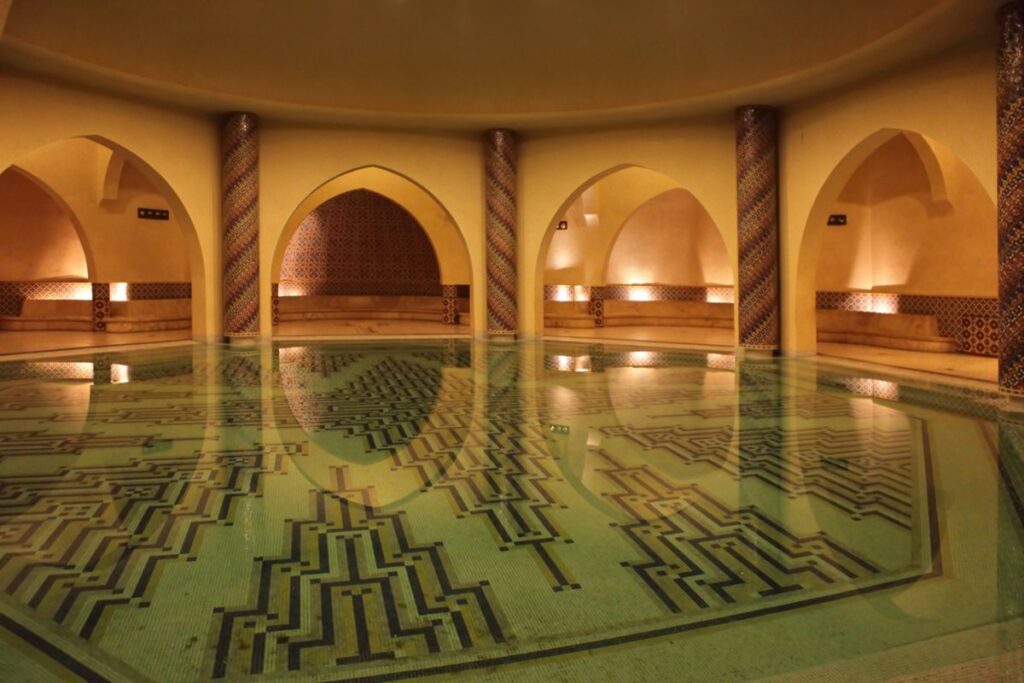Morocco, a land of enchantment and mystique, beckons travelers with its rich tapestry of culture and tradition. Amidst the bustling medinas and vibrant souks lies a hidden oasis of relaxation and rejuvenation – the Moroccan hammam. Steeped in history and cherished by locals and visitors alike, the hammam experience is essential to Moroccan culture.
Moroccan Hammam: A Journey of Tranquility and Tradition


The Essence of the Hammam
The term “hammam” originates from the Arabic word “hamma,” which means “to heat.” These traditional bathhouses are more than just places to cleanse the body; they are sanctuaries of tranquility and social gatherings. Moroccan hammams have a unique charm, combining ancient rituals with modern spa techniques.
A Journey Through Time
The history of the Moroccan hammam dates back centuries. They have been a focal point of Moroccan life, offering respite and restoration. Originally introduced by the Romans, the Hammam has evolved over time, incorporating Berber, Arab, and Moorish influences. Today, they continue to serve as communal spaces for relaxation and cleansing.
The Moroccan Hammam Experience
Entering a Moroccan hammam is like stepping into a different world. The atmosphere is saturated with the soothing scent of essential oils, and the sound of running water provides a calming backdrop. Traditional décor, including intricately designed tiles and soothing color schemes, creates a serene ambiance.
The Hammam Ritual
A typical Moroccan hammam experience is a multi-step ritual that begins with relaxation. Visitors often start by lounging in a warm room to prepare their bodies for the cleansing process. This phase helps open pores and promote perspiration.
The Ghassoul Scrub
Next comes the ghassoul scrub, a signature step in the hammam journey. Ghassoul, a natural clay from the Atlas Mountains, is mixed with rosewater and applied to the body. This exfoliating treatment rids the skin of impurities and dead cells, leaving it soft and radiant.



The Soap Massage
After the scrub, a luxurious soap massage follows. Using a special black soap made from olives and eucalyptus, the masseur or masseuse massages the body, creating a rich lather. This step cleanses the skin deeply and relaxes the muscles.
The Refreshing Rinse
A warm shower or soak in a soothing bath rinse away the soap and leaves the body feeling refreshed. This step is essential for cooling down after the hammam’s heat and steam.
The Moroccan Mint Tea Ceremony
No Moroccan hammam experience is complete without savoring a cup of Moroccan mint tea. This fragrant and refreshing beverage perfectly complements the relaxation and pampering process.
Benefits Beyond the Skin
While Moroccan hammams are renowned for their skin-nourishing treatments, their benefits extend far beyond the physical. The hammam experience is deeply ingrained in Moroccan culture, fostering social bonds and promoting mental well-being. It provides a haven for relaxation and self-care.
Tips for Your Hammam Adventure
- Respect Local Customs: Familiarize yourself with local etiquette and customs before entering a hammam to ensure a respectful and enjoyable experience.
- Hydrate: Drink plenty of water before and after your hammam session to stay hydrated.
- Arrive Early: Arriving early allows you to acclimate to the hammam’s environment and make the most of your experience.
- Embrace the Ritual: Embrace each step of the hammam ritual, from the ghassoul scrub to the soap massage, to fully benefit from the experience.
- Unplug and Unwind: Leave your digital devices behind and immerse yourself fully in the tranquility of the hammam.
A journey to Morocco is incomplete without indulging in the sensory delight of a traditional Moroccan hammam. It’s not merely a spa treatment but a cultural immersion and an opportunity to rejuvenate the body and soul. From the ancient origins to the modern-day allure, Moroccan hammams remain a cherished tradition and an experience like no other.
